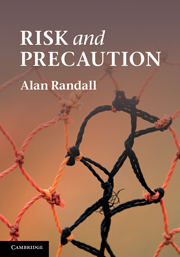Book contents
- Frontmatter
- Contents
- List of figures
- List of boxes
- Authors cited
- Acknowledgements
- List of acronyms
- Part I The precautionary principle – why so much fuss about such a simple idea?
- Part II Harm and chance – managing risk
- Part III Defining and justifying a coherent precautionary principle
- 6 A defensible precautionary principle must withstand these challenges
- 7 Toward a precautionary principle framework: evidence, threat, and remedy
- 8 Threat and evidence
- 9 Remedy
- 10 Precaution for utilitarians?
- 11 A robust and defensible precautionary principle
- Part IV Precaution in action
- Part V Conclusion
- References
- Index
9 - Remedy
Published online by Cambridge University Press: 05 June 2012
- Frontmatter
- Contents
- List of figures
- List of boxes
- Authors cited
- Acknowledgements
- List of acronyms
- Part I The precautionary principle – why so much fuss about such a simple idea?
- Part II Harm and chance – managing risk
- Part III Defining and justifying a coherent precautionary principle
- 6 A defensible precautionary principle must withstand these challenges
- 7 Toward a precautionary principle framework: evidence, threat, and remedy
- 8 Threat and evidence
- 9 Remedy
- 10 Precaution for utilitarians?
- 11 A robust and defensible precautionary principle
- Part IV Precaution in action
- Part V Conclusion
- References
- Index
Summary
In the context of the precautionary principle, our action concept is remedy: given credible evidence of plausible threat, what remedy is appropriate? Given the objective to explore the coherence of a PP that would make a distinct contribution beyond ordinary risk management (ORM), the set of appropriate remedies surely must include some that are stronger (in some sense) than those that would be prescribed by ORM. The standard ORM risk management tools – prohibiting or regulating the drivers of the threat; restoring and/or remediating any damage; accommodations such as avoiding, mitigating, and/or adapting to the threat; and insurance, self-insurance, and self-protection in its many forms – may well have roles in a precautionary policy package, but a meaningful PP would not be limited to the ORM toolkit and committed to using it only in ways consistent with ORM.
The distinctions between ORM and PP remedies are likely to be matters of timing and degree. Consistent with precaution, remedies may be implemented in advance to head off uncertain threats; and they may be calibrated to include safety margins, themselves a matter of degree because safety margins appear in ORM policy practice, too.
Precautionary remedies – must they always involve prohibition?
Critics often focus on a caricature of the PP, in which novel interventions or long-standing practices flagged as risky are prohibited in response to unsubstantiated threats of harm.
- Type
- Chapter
- Information
- Risk and Precaution , pp. 134 - 171Publisher: Cambridge University PressPrint publication year: 2011



